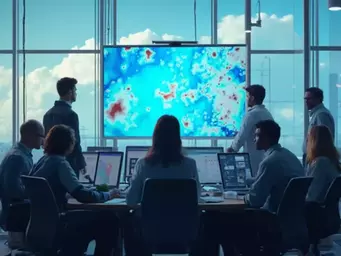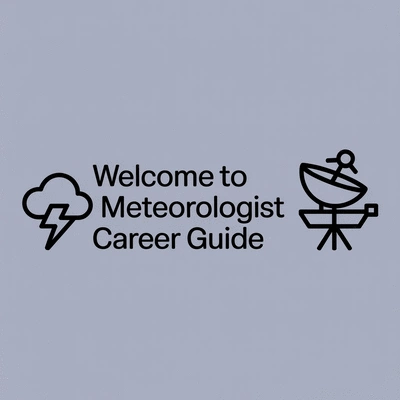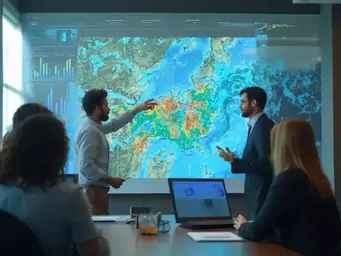Have you ever considered how hands-on experience can dramatically enhance your understanding of meteorology? Engaging with practical skills is essential for anyone aspiring to forecast the weather accurately.
What You Will Learn
- The importance of laboratory work in applying theoretical meteorological concepts.
- Key data analysis techniques for transforming raw weather data into actionable insights.
- How remote sensing technologies enhance real-time weather observation and accuracy.
- Essential methods for collecting and analyzing climate data effectively.
- Statistical approaches that improve forecasting accuracy, including climate normals.
- The significance of mastering meteorological charts and their role in weather forecasting.
- Career pathways available for meteorologists leveraging their practical skills.
- The impact of climate change on meteorological practices and forecasting methods.
Key Practical Skills in Meteorology
This visual highlights the fundamental areas of practical skill development crucial for aspiring meteorologists, emphasizing their interconnectedness and importance.
Laboratory Work
Hands-on experiments to apply theoretical concepts and understand atmospheric processes.
- ✓ Heat transfer experiments
- ✓ Pressure measurements
- ✓ Cloud type identification
Data Analysis & Remote Sensing
Transforming raw weather data into meaningful insights using various tools and technologies.
- ✓ Statistical methods for trends
- ✓ Satellite & radar data interpretation
- ✓ Software for modeling & visualization
Data Collection Techniques
Mastering methods and instruments for gathering accurate weather and climate information.
- ✓ Identifying reliable data sources
- ✓ Using barometers & anemometers
- ✓ Exploring weather balloons
Chart Interpretation & Forecasting
Reading and interpreting meteorological charts and developing accurate forecasting skills.
- ✓ Analyzing isotherms & isobars
- ✓ Probabilistic forecasting
- ✓ Numerical Weather Prediction (NWP)
Gaining Essential Practical Skills in Meteorology
In the world of meteorology, practical skills are just as crucial as theoretical knowledge. Gaining hands-on experience through laboratory work not only solidifies your understanding of weather science but also prepares you for the challenges of predicting and analyzing weather patterns. As someone deeply passionate about fostering the next generation of weather scientists, I believe that these essential skills can pave the way for a rewarding career in meteorology.
So, what does this journey look like? Let’s dive into the various practical skills every aspiring meteorologist should focus on.
Understanding the Role of Laboratory Work in Weather Science
Laboratory work plays a pivotal role in meteorology education. Engaging in hands-on experiments allows students to apply theoretical concepts in a controlled environment. Whether it's analyzing atmospheric samples or studying weather phenomena, labs provide insights that textbooks simply can't offer!
- Conducting experiments on heat transfer to understand temperature variations.
- Measuring atmospheric pressure and its effects on weather systems.
- Identifying cloud types through hands-on observation and categorization.
These activities not only enhance your understanding but also cultivate critical thinking skills that will serve you well in the field.
Why Aspiring Meteorologists Should Focus on Data Analysis
Data analysis stands at the core of meteorological forecasting. By honing your skills in this area, you can transform raw weather data into meaningful insights. The ability to interpret complex datasets is essential for accurate weather predictions, greatly impacting everything from daily forecasts to long-term climate assessments.
- Utilizing statistical methods to analyze historical weather trends.
- Learning software tools for modeling and visualizing weather data.
- Understanding the significance of data accuracy and its implications on forecasts.
Emphasizing data analysis will not only equip you with the necessary skills but also make you an invaluable asset in a variety of meteorological careers.
Utilizing Remote Sensing in Meteorological Research
Remote sensing technologies have revolutionized weather observation and data collection. By leveraging satellite imagery and radar systems, meteorologists can gather real-time data from vast areas, enhancing the accuracy of weather forecasts. This technology allows for a much more comprehensive understanding of atmospheric conditions.
- Using satellites to monitor cloud cover and moisture levels.
- Employing Doppler radar to track storm systems in real-time.
- Analyzing data from remote sensing to predict severe weather events.
Integrating remote sensing into your skill set will not only sharpen your analytical abilities but also prepare you for the future of meteorological research.
Fundamental Techniques for Weather Data Collection
Collecting and analyzing weather data forms the backbone of meteorological practice. Here, we’ll explore the essential techniques that aspiring meteorologists must master.
Methods for Gathering and Analyzing Climate Data
Collecting historical climate data can seem daunting, but it’s a crucial step in understanding weather patterns. Here’s a simple step-by-step guide to get you started:
- Identify reliable data sources, such as government meteorological agencies.
- Utilize online databases to access historical weather records.
- Organize the data by variables such as temperature, precipitation, and wind speed.
- Analyze the data using statistical methods to identify patterns.
Following these steps will give you a solid foundation in climate data collection and analysis, essential for your future in meteorology.
Statistical Approaches to Weather Forecasting
Statistical methods are invaluable tools in weather forecasting. Techniques like climate normals and precipitation probabilities allow meteorologists to make informed predictions about future weather conditions. Understanding these approaches can greatly enhance your forecasting accuracy!
- Learning how to calculate climate normals for different regions.
- Employing probabilistic forecasting techniques to communicate uncertainty.
- Utilizing historical data to create reliable predictive models.
Mastering these statistical approaches will not only build your confidence but also improve your forecasting skills significantly.
Incorporating Weather Instruments in Data Collection
To collect accurate weather data, familiarity with various meteorological instruments is essential. From weather balloons to Doppler radar, these tools provide critical information needed for effective analysis.
- Understanding the function of barometers in measuring atmospheric pressure.
- Utilizing anemometers to measure wind speed and direction.
- Exploring weather balloons for upper atmosphere data collection.
Incorporating these instruments into your training will enrich your practical knowledge and enhance your data collection skills.
Mastering Meteorological Charts for Effective Interpretation
Being able to read and interpret meteorological charts is a must-have skill for any aspiring meteorologist. Let’s explore the different types of charts and their applications.
Types of Charts Used in Meteorology
Meteorologists use various charts to visualize weather data and make informed predictions. Here’s a quick overview of some common types:
- Isotherms: Lines connecting points of equal temperature.
- Isobars: Lines connecting points of equal pressure, crucial for identifying weather systems.
- Station Models: Compact representations of weather data from observing stations.
Familiarity with these charts will improve your understanding of weather dynamics and enhance your forecasting abilities.
Practical Exercises in Chart Analysis
To strengthen your skills in interpreting meteorological charts, engaging in hands-on exercises is key. Here are a few practical activities you can try:
- Analyzing Skew-T diagrams to assess atmospheric stability.
- Interpreting Emagram diagrams for temperature and moisture profiles.
- Participating in group discussions to compare interpretations and enhance understanding.
These exercises provide invaluable experience and will elevate your chart analysis skills.
Understanding Weather Maps and Their Applications
Weather maps are indispensable tools for predicting weather systems. By learning to read and interpret these maps, you can make more accurate forecasts.
- Identifying high and low-pressure systems on maps.
- Recognizing fronts and their implications for weather changes.
- Applying your knowledge to real-time weather scenarios for practice.
Understanding weather maps will enhance your forecasting competency and prepare you for practical application in the field.
Developing Effective Weather Forecasting Skills
As you continue your journey, developing effective forecasting skills is vital. Let’s break down the key components that contribute to successful weather forecasts.
Understanding Forecast Terminology and Warnings
Diving into the world of forecasting means familiarizing yourself with the terminology used in the field. Here are a few key terms you should know:
- Watch: Conditions are favorable for severe weather.
- Warning: Severe weather is imminent or occurring.
- Advisory: Non-severe weather that may still cause inconvenience.
Understanding these terms will help you communicate forecasts effectively, ensuring clarity for your audience.
Probabilistic Forecasts: What You Need to Know
Probabilistic forecasting introduces a new dimension to weather predictions, quantifying the uncertainty inherent in weather systems. Here’s what you should keep in mind:
- Understanding how to express probabilities in forecasting.
- Learning to interpret forecast probabilities for better decision-making.
- Using probabilistic models to enhance prediction reliability.
Grasping these principles will enhance your forecasting acumen and improve accuracy in your predictions.
Employing Numerical Weather Prediction Techniques
Numerical Weather Prediction (NWP) is at the forefront of modern forecasting. Using mathematical models to simulate atmospheric conditions, NWP can provide detailed forecasts.
- Learning the basic principles of NWP and its applications.
- Understanding the importance of initial conditions in model accuracy.
- Exploring different model outputs and their interpretations.
Gaining proficiency in these techniques will prepare you for the complexities of weather forecasting in your future career.
Engaging in Hands-on Labs: Practical Meteorology Skills
Hands-on laboratory experiences are invaluable for developing practical meteorology skills. Let’s delve into what you can expect from these experiences.
Key Laboratory Exercises for Aspiring Meteorologists
Laboratory exercises offer a practical approach to learning. Here are some key activities you might encounter:
- Conducting experiments on heat transfer to understand energy dynamics.
- Identifying cloud types through field observations and discussions.
- Simulating weather scenarios based on collected data.
These exercises provide foundational experiences that will serve you well in your meteorological career.
Integrating Modern Technology in Meteorology Labs
With the advancement of technology, modern meteorology labs are evolving. Here’s how technology is enhancing lab work:
- Utilizing software tools for data analysis and visualization.
- Incorporating digital platforms for collaborative projects.
- Employing simulations to model weather scenarios dynamically.
Integrating these technologies will keep you ahead in the ever-changing field of meteorology.
Exploring Environmental Science and Its Connection to Meteorology
Understanding the intersection of meteorology and environmental science is crucial, especially in the context of climate change. Here are some points to consider:
- Exploring how meteorological data informs environmental policy.
- Understanding the impact of climate change on weather patterns.
- Examining sustainable practices in meteorological research.
Embracing this connection will enrich your understanding of both fields and enhance your contributions to environmental conservation efforts.
Linking Practical Skills to Career Opportunities in Meteorology
Lastly, let’s explore how the practical skills you develop can translate into various career opportunities in meteorology.
Career Pathways for Meteorologists: Skills That Matter
The skills you've acquired through labs, data analysis, and chart interpretation can lead to exciting career paths. Consider the following:
- Weather forecasting roles in government agencies and private sectors.
- Research positions focusing on climate change and atmospheric studies.
- Community outreach and education roles that engage the public in weather science.
Connecting your practical skills to these opportunities will empower you to make informed career decisions.
Professional Certifications and Development Resources
Enhancing your employability can be achieved through professional certifications in meteorology. Here’s what you should explore:
- Certification programs from recognized meteorological organizations.
- Workshops and online courses to build specialized knowledge.
- Networking opportunities through meteorological societies.
Taking advantage of these resources will not only boost your credentials but also open doors to new opportunities in your meteorology career.
Quick Summary
Here's a brief recap of the key points discussed so far:
- The importance of practical skills in meteorology, including hands-on laboratory work.
- Data analysis is crucial for transforming raw weather data into meaningful insights.
- Remote sensing technologies enhance real-time data collection and improve forecasting accuracy.
- Understanding and interpreting meteorological charts are essential for effective weather predictions.
Frequently Asked Questions About Practical Meteorology Skills
Why are practical skills important in meteorology?
Practical skills like laboratory work and data analysis are crucial in meteorology because they allow aspiring meteorologists to apply theoretical concepts in real-world scenarios, interpret complex datasets, and make accurate weather predictions. These hands-on experiences are essential for developing a deep understanding of atmospheric processes and preparing for a successful career.
What role does data analysis play in weather forecasting?
Data analysis is fundamental to weather forecasting. It involves transforming raw weather data into meaningful insights by utilizing statistical methods to analyze historical trends, learning software tools for modeling and visualization, and understanding data accuracy. These skills are vital for making precise predictions and assessments, impacting everything from daily forecasts to long-term climate studies.
How do remote sensing technologies improve forecasting accuracy?
Remote sensing technologies, such as satellite imagery and radar systems, significantly enhance forecasting accuracy by enabling meteorologists to gather real-time data from vast geographical areas. This comprehensive data allows for a more detailed understanding of atmospheric conditions, improved tracking of storm systems, and better prediction of severe weather events.
What are some essential meteorological charts and their uses?
Essential meteorological charts include isotherms (lines connecting points of equal temperature), isobars (lines connecting points of equal pressure, useful for identifying weather systems), and station models (compact representations of weather data from observing stations). Mastering the interpretation of these charts is vital for understanding weather dynamics and making informed predictions.
How does climate change influence meteorological practices?
Climate change profoundly influences meteorological practices by altering weather patterns, increasing the frequency of extreme weather events, and shifting seasonal patterns. This requires meteorologists to adapt their forecasting approaches to account for these changes, integrate new data sources, and develop more sophisticated models to make accurate and reliable predictions in a changing climate.
Reflecting on the Role of Practical Skills in Meteorology
As I reflect on my journey in meteorology, it becomes clear just how vital practical skills are in this field. Hands-on laboratory experiences and effective chart analysis are not just beneficial; they are essential components of a meteorologist's toolkit. By engaging in lab work, you can deepen your understanding of atmospheric processes and apply theoretical knowledge in real-world scenarios.
Moreover, mastering chart analysis helps you visualize and interpret complex data, making it easier to forecast weather patterns accurately. This combination of practical skills forms a strong foundation for anyone looking to excel in meteorology.
- Hands-on laboratory experiences enhance theoretical understanding
- Chart analysis skills foster accurate weather forecasting
- Practical skills bridge the gap between theory and real-world application
So, if you're an aspiring meteorologist, I encourage you to prioritize these practical experiences as they will significantly shape your career in this dynamic field. Embracing these skills not only builds your confidence but also prepares you for the challenges ahead.
Encouraging Engagement and Continued Learning
Continuing your education in meteorology is vital, and I invite you to actively engage in lab exercises and utilize modern digital tools to enhance your learning. Hands-on experiences, like participating in local weather observation clubs or online simulations, can provide practical insights that textbooks often miss. Plus, with technology continually evolving, staying updated on the latest software and tools can put you ahead in your meteorological journey.
Here are some ways to actively participate in your learning:
- Join workshops that focus on lab skills and data analysis
- Participate in online meteorology courses
- Engage in community projects related to weather observation
- Connect with mentors in the field for guidance and support
Each step you take towards engagement not only enriches your knowledge but also connects you with like-minded individuals who share your passion for meteorology!
Understanding the Impact of Climate Change on Meteorology
Climate change is reshaping our planet's weather patterns and presenting new challenges for meteorologists. As an educator and advocate for future meteorologists, I believe it's crucial to understand how these shifts impact forecasting methods. Climate change influences everything from temperature extremes to precipitation patterns, requiring us to adapt our forecasting approaches to be more accurate and reliable, as highlighted by discussions on the future of weather forecasting.
Some key impacts of climate change on meteorology include:
- Increased frequency of extreme weather events
- Shifts in seasonal weather patterns
- Difficulty in predicting precipitation and drought cycles
By grasping these concepts, aspiring meteorologists can better prepare for the complexities of forecasting in a changing climate. As you navigate your journey, remember that understanding the science behind climate change is essential for making informed predictions that can help communities adapt and prepare for future challenges.
Recap of Key Points
Here is a quick recap of the important points discussed in the article:
- Hands-on laboratory work is essential for applying theoretical knowledge in meteorology.
- Data analysis skills are crucial for interpreting weather data and enhancing forecasting accuracy.
- Familiarity with remote sensing technologies improves real-time weather observation.
- Understanding statistical methods helps in making informed weather predictions.
- Proficiency in using meteorological instruments is vital for accurate data collection.
- Chart analysis skills enhance the ability to visualize and interpret weather data.
- Engagement with community projects and continuous learning are important for professional development.









